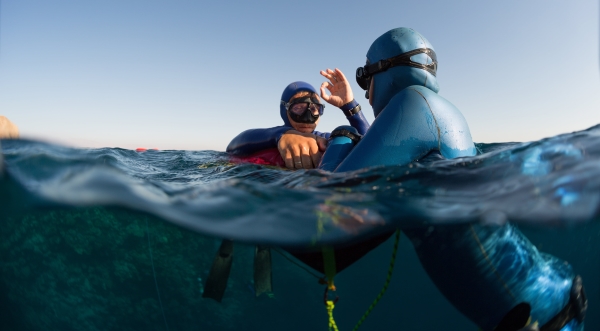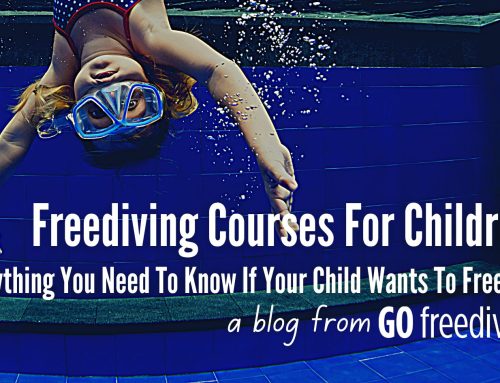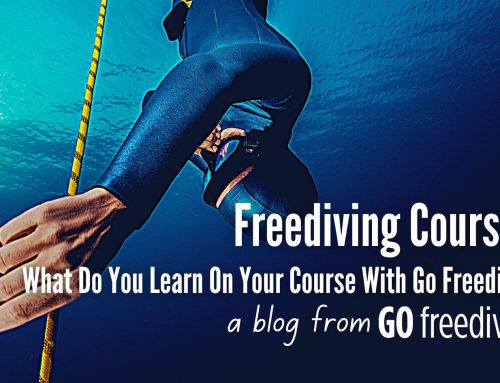Welcome to part six of The Beginner’s Guide to Freediving, the best place to start your freediving journey. If you’re planning to start freediving, this chapter covers safety for freediving – how to dive safe and buddy for different disciplines.
Safety for Freediving
Safety for freediving is paramount, as we are often pushing our bodies whilst holding our breath. Consequently the number one rule you should always, always remember is this:
NEVER FREEDIVE ALONE!
You should never freedive without a qualified buddy with you at all times, one who is trained and able to rescue you from any scenario you might find yourself in. Safety for freediving means you should ensure that you have a dive plan, a risk assessment and emergency plan, and have told people where you are diving.
You must always ensure that your safety equipment and buoyancy matches the conditions that you find yourself diving in. If you are diving past your point of neutral buoyancy and the natural bottom is deeper than that which your buddy can comfortably rescue you from with zero preparation, or there is any current, or you cannot see the diver at all times, then you must dive with a line and a lanyard, either secured to a boat or a large freediving buoy. You cannot predict what may happen to your body or the environment whilst you freedive, and so you must always dive with every possible safety angle covered. It does not matter how capable a freediver you are; freak accidents can and do happen, and without obeying basic safety rules you cannot guarantee your personal safety.
So, when you’re diving at a new location, ask yourself these ‘Safety for Freediving’ questions:
- Who has dived here before and what can I ask them about the conditions?
- What tides, currents and weather conditions do I need to know about?
- What is the visibility like?
- How deep is the natural bottom?
- How capable am I to rescue my buddy without preparation if they were on the bottom?
- Have I put a safety plan in place that would satisfy my closest family and friends?
- Am I wearing an easily accessible knife or line cutter in case I get entangled in fishing line?
If the natural bottom is deeper than you could comfortably and immediately dive down and pick up your buddy from the bottom and safely recover the both of you, use a line, lanyard and buoy. If there is a current, use a line, lanyard and buoy. If there is limited visibility use a line, lanyard and buoy. Whenever I am teaching a student who seems to have a somewhat lax attitude to their own personal safety, I always remind them before every dive, “imagine your mother is watching you.”
The primary responsibility for your safety as a freediver is you. Choose your equipment, buddy, dive conditions, depth and time wisely. After making sensible decisions about your dive, the next level of safety is your buddy. Buddying is slightly different for certain disciplines, although there are similarities across all. Let’s look at buddying in general and how to buddy for different disciplines.
Safety for Freediving – Buddying for Freediving
First and foremost, as a buddy your job is to be there for the diver. That means knowing what they are going to do, what they expect you to do, and how you can be the most effective and reliable buddy. Clear communication is critical. There is nothing more frustrating for a freediver than having your buddy speak to you during static so quietly that you can’t hear them, or failing to meet you at the depth that you had agreed. Before every dive, swim or breath-hold, make sure you know what you need to do to support the diver in an effective fashion. This can also mean checking that their mask does not have any hair caught under the skirt, that the skirt is completely under the wetsuit hood or that their snorkel is clear of the water when preparing to dive. The more you get to know the diver, the safer a buddy you can become as you learn their body language and the little signs that things are okay or not.
We’ll be looking at how to rescue a diver in a later article, but in the meantime here are some general safety for freediving points for each discipline with regard to buddying correctly.
Safety for Freediving – Static Apnea
Buddying for static requires multitasking skills and complete attentiveness. You need to keep an eye on a stopwatch, looking out for signs and returned signals, and keeping the diver in position, as well as coaching them if they want it. The practice of tapping the diver, usually on the shoulder, and looking for acknowledgement via a raised finger is employed to assess the diver’s consciousness and must be done at least every 15 seconds for the last third of their breath hold.
- Ensure you know you the diver’s name. This may sound crazy, however time and time again I have seen the buddy look with horror at me half way through the diver’s breath hold and ask, “what’s their name again?!”
- Know how long they are going to hold their breath for, when they want to be tapped and where, and how they will return the signal.
- Know what count down they want and when (if at all) they want to be told how far into the breath hold they are. Some divers prefer not to know how long they are holding their breath for, letting the buddy tap them at their own discretion.
- If the diver is wearing a sufficiently buoyant wetsuit then they will usually choose to breathe up on their back. Help them roll gently into position and make sure their head does not bump the edge of the pool as they do so.
- Ensure that the diver stays perpendicular to the side of the pool, their head close to the side. When practicing static, many divers feel as if they are drifting off, circling, or sinking in the water and this can be very disconcerting. By keeping them perfectly in position, you help alleviate these sensations.
- When touching the diver, do so as gently and unobtrusively as possible. Use just a finger on their shoulder or hip, or use part of their wetsuit. Do not touch their head or grab them.
- When speaking to the diver, bear in mind that external pool noise and their wetsuit hood will impede their ability to hear you. Get your head close to theirs and speak clearly.
- Do not get distracted by other things going on around you. Keep a clear eye on the time and what the diver is doing.
- When the diver has turned over and has started their breath hold, do not place your hand on their back, head, or any other part of their body unless they have asked you to. Keep them in position gently, using minimal touching.
- Communicate as you have agreed via taps and voice. If the diver has requested you keep quiet then don’t have a conversation with someone else. All your attention should be on the diver at all times.
- When the diver wants to come up, help their hands find the edge of the pool and help them bring their legs underneath them. When they raise their head, tell them to breathe, use their name, and make sure you are close enough to intervene if necessary. It can be very helpful to lightly hold the diver under their armpit so that if they were to suffer a hypoxic fit or blackout you already have a hold of them. In competition you are not allowed to touch the diver after they surface, so bear this in mind when practicing for competition.
- If you are practicing static in open water then you can use a torpedo buoy or other float for the diver to hold onto as they come up, or give them your forearm.
Safety for Freediving – Dynamic Apnea
Whether buddying for dynamic with or without fins, you should always ensure that you wear fins to help you keep pace with the diver. Wearing fins, the diver will always move faster under the water than on top, so you will usually need to use your arms to help you keep pace. Be careful when using your snorkel, as it’s easy to fill it with water when you are looking at the diver!
- Start swimming on the surface slightly ahead and to the side of the diver for at least the last third of their anticipated swim.
- Give the diver room to turn at the end of the pool and never get in their way.
- Whenever the diver decides to surface, you must be there to coach them to breathe, using their name and guiding them to the side of the pool if there are in the middle and/or offering a buoy, float, or your forearm for support. Again, lightly place your hand under their armpit for support, to guide them to the side if necessary and in case they were to suffer a hypoxic fit or black out.
Safety for Freediving – Buddying for Depth Disciplines
Your job as a buddy, in most scenarios, is to meet the diver at depth and ascend with them to the surface, ready to intervene if anything goes wrong. It does not matter how you get to the prescribed depth, just that you are there waiting. I usually recommend pulling down the line to save your energy. You should always be diving with a dive line and the diver attached to the line by a freediving lanyard. Here are some key safety for freediving points to remember:
- Know how deep the diver is going to dive, roughly how long their dive will be, and where they expect you to meet them. On a depth dive this should usually be at least 10m deep.
- After the diver has left the surface, if you cannot see them for the whole of the dive, hold onto the dive line. You should be able to feel the vibration of the lanyard running down the rope, it stopping, and then a pull when the diver begins the ascent. This, as well as timing the dive, helps you decide when is best to leave the surface to meet the diver. Some dive set-ups include the use of a ‘fish finder’ so that you can see the progress of the diver and when they make their turn to come back up.
- When descending down the dive line to meet the diver, make sure you look where you are going to ensure you do not collide with them.
- When you get the correct depth, hold onto the line to keep you at depth and do not let go until the diver’s eyes are level with yours.
- Ascend at the same time as the diver. If they speed up, you speed up. If they slow down, you slow down. If you are going too fast then splay your legs and arms to slow yourself down.
- You should be no more than a hand’s grab away from the diver at any time.
- Make sure you look at the surface periodically to check it is clear.
- Use pre-arranged hand signals to let the diver know if they need to move a certain way, for example nearer to the line.
- On the surface, make sure the diver is holding onto something for support, put one of your hands lightly underneath their armpit, clearly and loudly tell them to breathe and use their name. Sometimes it is helpful to get them to copy you doing correct recovery breathing if theirs is erratic. By placing your hand lightly under their armpit you prove to them and you that you are close enough to immediately intervene if necessary. Bear in mind that in competition you are not allowed to touch the diver, so if you intend on competing then practice being close enough to touch the diver but without placing a hand on their body. Stay with the diver for at least thirty seconds or until they have completely recovered, as a blackout can still occur after thirty seconds of breathing. Get right up next to them, encourage them to breathe and use their name
- If you are buddying as a group of three, then person A will be diving buddied by person B, whilst person C prepares for their dive. When A has sufficiently recovered, C moves to the line and dives, to be buddied by A whilst B prepares for their dive and so on. You must ensure that there is sufficient time between dives so that the person who has just dived has enough time to recover before buddying.
Safety for Freediving – Buddying when Recreational Diving
Recreational diving is assumed to be diving to depths less than twenty meters with good visibility and minimal current. Remember, if you are diving past your point of neutral buoyancy and the natural bottom is deeper than than that from which your buddy can comfortably rescue with zero preparation, or there is any current, or you cannot see the diver at all times, then you must dive with a line and a lanyard, either secured to a boat or a large freediving buoy. When recreational diving, obey the ‘one up, one down’ rule, whereby one of you dives whilst the other one observes. Again, communication is key and surface safety vital. You must always dive with a buoy or boat support and offer a buoy or your forearm to the diver when they surface.
Safety for Freediving – Buddying when Spearfishing
The fact that you are going out to spear fish is no excuse for lax safety or to dive without a buddy. The safest way to spearfish is to dive with one gun between two divers, the diver being attached to a line running to the buoy. Very accomplished spearos that I know say that diving this way has never affected their fishing and, if the spearfisher were to suffer a blackout at depth, then they could be pulled to the surface.
Finally…
Ultimately there is no depth deeper, no photograph better, or no fish more important than your precious and beautiful life. Done correctly, freediving is an incredibly safe and enjoyable sport and it is your responsibility to ensure that your every dive is as safe as it can possibly be.
Written by Emma Farrell
The Beginner’s Guide to Freediving is written by Emma Farrell. She is one of the world’s leading freediving instructors and has been teaching freediving since 2003. She is the author of the book ‘One Breath, a Reflection on Freediving’, has written courses that are taught worldwide, taught gold medal winning Olympic and Paralympic athletes, and has appeared numerous times on television teaching everyone from Hugh Fearnley-Whittingstall to Ellie Simmonds how to freedive.
Learn to freedive with the author of The Beginner’s Guide to Freediving
Go Freediving is the longest established, most experienced and friendliest freediving course provider in the UK, led by world class freediving instructor trainer Emma Farrell, and her team of personally trained instructors. No other course provider has such a good instructor to student ratio, safety record and personal touch.
Whether you’re a beginner dipping your toes into the world of freediving, a seasoned pro looking to turn professional, or simply a freediver of any level who wants the best freediving holiday in the world, we’re here for you!
Learn more about Freediving
Read the previous chapter of The Beginner’s Guide to Freediving – ‘Equipment for Freediving’ here now
Read the next chapter of The Beginner’s Guide to Freediving – ‘Breathing for Freediving’ here now
Keep in touch with everything Freediving
Subscribe to our mailing list for weekly newsletters with exclusive articles, news, films, offers and more!












Leave A Comment